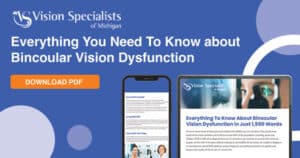What is Convergence Excess? Convergence Excess Definition
Convergence excess, often referred to as convergence excess esophoria in clinical terms, presents as an ocular anomaly characterized by an exaggerated inward movement of the eyes when attempting to focus on nearby objects. Typically, the eyes exhibit a natural convergence, adjusting their alignment to bring close-up objects into a unified and clear image. However, in instances of convergence excess, this convergence movement surpasses the typical range, resulting in an imbalance that can lead to ocular strain and discomfort. This condition disrupts the coordination of the eye muscles, deviating from the normal eye alignment.Convergence Excess Causes
 Several factors contribute to the development of convergence excess, including:
Several factors contribute to the development of convergence excess, including:- Genetic Predisposition: Individuals with a family history of vision disorders are more prone to convergence excess.
- Underlying Eye Conditions: Conditions such as strabismus (crossed eyes) or amblyopia (lazy eye) may predispose individuals to convergence excess.
- Prolonged Near Work: Excessive time spent reading, using digital devices, or performing close-up tasks can strain the eye muscles, potentially leading to convergence excess.
- Neurological Factors: Certain neurological conditions or abnormalities may disrupt the coordination of eye movements, contributing to convergence excess.
- Binocular Vision Dysfunction: Binocular vision dysfunction, also known as binocular vision disorders (BVD), is another significant contributing factor to the development of convergence excess. This condition encompasses a range of abnormalities in the way both eyes work together to perceive depth and form a unified visual image.
Convergence Excess Symptoms
Recognizing the following symptoms of convergence excess is crucial for timely intervention. Common symptoms include:- Eyestrain: Individuals with convergence excess often experience discomfort or fatigue in the eyes, especially after prolonged near work.
- Double Vision: Excessive inward eye movement can cause double vision, making it challenging to focus on objects up close.
- Headaches: Persistent headaches, particularly around the temples or forehead, may indicate underlying visual strain associated with convergence excess.
- Difficulty Concentrating: Tasks requiring sustained focus, such as reading or computer work, may become increasingly challenging for individuals with convergence excess.
- Blurred Vision: As the eyes struggle to maintain proper alignment and focus, the clarity of vision diminishes, resulting in blurred or fuzzy images. This blurring effect can worsen with prolonged near work or activities that demand intense visual concentration.
Convergence Excess Treatment Options
Effective management of convergence excess typically involves a combination of therapeutic approaches tailored to individual needs. To treat convergence excess, options may include:- Optometric Vision Therapy: Vision therapy exercises, conducted under the guidance of a trained optometrist, or ophthalmologist, aim to improve eye coordination and strengthen eye muscles. to alleviate the uncomfortable symptoms of convergence excess.
- Prism Lenses: Specialized prism eyeglass lenses can help alleviate symptoms of convergence excess by altering the way light enters the eyes, thereby reducing the need for excessive convergence within the visual system.
- Orthoptic Exercises: These exercises focus on enhancing eye coordination and flexibility, helping individuals better control their eye movements and alleviate uncomfortable symptoms of convergence excess.
- Behavioral Modifications: Simple adjustments in daily habits, such as taking frequent breaks during near work or maintaining proper posture, can reduce eye strain and alleviate symptoms of convergence excess. These small behavioral modifications can make a significant difference.
- Light Therapy (Syntonics): Syntonics is emerging as a promising adjunctive treatment option for convergence excess. This innovative approach utilizes specific wavelengths of light to stimulate the visual system and promote optimal visual function.
Binocular Vision Dysfunction (BVD)
BVD is when the eyes don’t work together properly, causing problems with depth perception and clear vision. Symptoms include double vision, eyestrain, headaches, and trouble seeing clearly, especially during close-up activities. Diagnosis involves a thorough eye exam by a vision specialist. Treatment options may include vision therapy and special lenses to help improve how the eyes work together. By recognizing the signs of BVD and getting the right help, people can manage their symptoms and improve their vision.Frequently Asked Questions
Can convergence excess be cured?
While convergence excess may not be completely cured by an eye doctor, its symptoms can be effectively managed through appropriate treatment strategies. Vision therapy, prism lenses, and lifestyle modifications can significantly improve symptoms and enhance visual comfort for individuals with convergence excess.Is convergence excess common in children?
Yes, convergence excess can affect individuals of all ages, including children. Early detection and intervention are crucial for minimizing the impact of this condition on a child's visual development and academic performance. Children with convergence excess tend to have difficulties reading materials in school.Can convergence excess lead to long-term complications?
Untreated convergence excess can lead to persistent visual discomfort, reduced productivity, and academic challenges, particularly in children. However, with timely intervention and proper management, most people with convergence excess can effectively manage their symptoms and lead fulfilling lives.Are there any preventive measures for convergence excess?
While certain risk factors for convergence excess, such as genetic predisposition, cannot be modified, adopting healthy visual habits and taking regular breaks during near work can help reduce the risk of developing or making convergence excess worse.Experiencing BVD Symptoms or Convergence Excess? Contact Vision Specialists Today
Convergence excess poses significant challenges to individuals striving for optimal visual comfort and functionality. By understanding the causes, symptoms, and treatment options associated with this condition, individuals can take proactive steps to address visual discomfort and improve their quality of life. Seeking professional guidance from the qualified eye care practitioners at Vision Specialists of Michigan is essential for accurate diagnosis and personalized treatment planning tailored to individual needs. With timely intervention and effective management strategies, individuals with convergence excess or BVD can embark on a journey toward clearer, more comfortable vision.Take the BVD test and get in touch.Filed Under:







